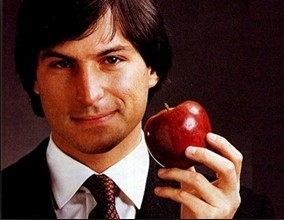CHAPTER TEN
第十章
THE MAC IS BORN
Mac誕生了
You Say You Want a Revolution
你說你想要一場革命
Jef Raskin’s Baby
杰夫拉斯金的寶貝
Jef Raskin was the type of character who could enthrall Steve Jobs—or annoy him. As it turned out, he did both. A philosophical guy who could be both playful and ponderous, Raskin had studied computer science, taught music and visual arts, conducted a chamber opera company, and organized guerrilla theater. His 1967 doctoral thesis at U.C. San Diego argued that computers should have graphical rather than text-based interfaces. When he got fed up with teaching, he rented a hot air balloon, flew over the chancellor’s house, and shouted down his decision to quit.
杰夫·拉斯金是那種能讓史蒂夫·喬布斯著迷——或者是厭煩的人。事實證明,兩者他都做到了。拉斯金是個很有哲學家范兒的人,有時幽默頑皮,有時又呆板沉悶,他學習過計算機科學,教過音樂和視覺藝術,管理過一家室內歌劇院,還組織過街頭劇場。他1967年在加州大學圣迭戈分校完成的博士論文中提出,計算機應該擁有圖形界面,而不是基于文本的界面。他在厭倦了教書之后,就租了一只熱氣球,飛到校長家上空,大聲喊出了自己的辭職決定。
When Jobs was looking for someone to write a manual for the Apple II in 1976, he called Raskin, who had his own little consulting firm. Raskin went to the garage, saw Wozniak beavering away at a workbench, and was convinced by Jobs to write the manual for $50. Eventually he became the manager of Apple’s publications department. One of Raskin’s dreams was to build an inexpensive computer for the masses, and in 1979 he convinced Mike Markkula to put him in charge of a small development project code-named “Annie” to do just that. Since Raskin thought it was sexist to name computers after women, he redubbed the project in honor of his favorite type of apple, the McIntosh. But he changed the spelling in order not to conflict with the name of the audio equipment maker McIntosh Laboratory. The proposed computer became known as the Macintosh.
1976年,喬布斯找人為AppleII編寫操作手冊,他給當時已經擁有一家小型咨詢公司的拉斯金打了電話。拉斯金來到喬布斯的車庫,看到了在工作臺上埋頭苦干的沃茲尼亞克,并被喬布斯說服,接受了以50美元的報酬為他們編寫操作手冊。后來,拉斯金成為了蘋果公司出版部門的全職經理。他有一個夢想,就是為大眾制造價格低廉的電腦。1979年,他說服了邁克·馬庫拉,成為了小規模項目“安妮”的負責人。然而拉斯金認為,用女人的名字命名電腦是帶有性別歧視成分的,所以他更換了項目代號,用的是自己最喜歡的一種蘋果的名字:麥金托什(McIntosh)。但為了避免與音頻設備制造商麥金托什實驗室(McIntoshLaboratory)的名字有沖突,他故意改變了字母的拼寫。于是,新電腦的名字變成了麥金塔(Macintosh)。
Raskin envisioned a machine that would sell for $1,000 and be a simple appliance, with screen and keyboard and computer all in one unit. To keep the cost down, he proposed a tiny five-inch screen and a very cheap (and underpowered) microprocessor, the Motorola 6809. Raskin fancied himself a philosopher, and he wrote his thoughts in an ever-expanding notebook that he called “The Book of Macintosh.” He also issued occasional manifestos. One of these was called “Computers by the Millions,” and it began with an aspiration: “If personal computers are to be truly personal, it will have to be as likely as not that a family, picked at random, will own one.”
拉斯金預想中的電腦售價1000美元,像家用電器一樣操作簡單,并且將屏幕、鍵盤和電腦本身整合為一體。為了降低成本,他計劃使用5英寸的小屏幕,以及非常便宜(性能也很落后)的微處理器——摩托羅拉6809。拉斯金自詡為哲學家,他不斷地把自己的想法記錄在本子上,稱之為“麥金塔之書”。他還會偶爾發表一些宣言,其中之一叫做“數以百萬計的電腦”,開頭就表達了他遠大的志向:“如果個人電腦能真正走向每個人的話,那么任何一個家庭都應該擁有一臺。”
Throughout 1979 and early 1980 the Macintosh project led a tenuous existence. Every few months it would almost get killed off, but each time Raskin managed to cajole Markkula into granting clemency. It had a research team of only four engineers located in the original Apple office space next to the Good Earth restaurant, a few blocks from the company’s new main building. The work space was filled with enough toys and radio-controlled model airplanes (Raskin’s passion) to make it look like a day care center for geeks. Every now and then work would cease for a loosely organized game of Nerf ball tag. Andy Hertzfeld recalled, “This inspired everyone to surround their work area with barricades made out of cardboard, to provide cover during the game, making part of the office look like a cardboard maze.”
從1979年到1980年初,麥金塔項目一直處于奄奄一息的狀態。每隔幾個月,它就會面臨被解散的命運,但每一次拉斯金都能讓馬庫拉善心大發,項目便能得以延續。它的研究團隊只有4名工程師,辦公地點在蘋果公司以前的辦公樓,緊鄰美好地球餐廳,跟公司新建的主樓隔了幾個街區。辦公室里堆滿了玩具和無線電遙控的飛機模型(拉斯金的最愛),看上去就像個為極客們服務的日托中心。大家會時不時地停下手中的工作,玩一場組織松散的Nerf球游戲。正如安迪·赫茨菲爾德回憶的:“這讓大家都在自己的辦公區域四周圍上了紙板做成的擋板,以便在游戲的時候提供遮擋,這么一來,辦公室看上去就像個用紙板圍成的迷宮。”
The star of the team was a blond, cherubic, and psychologically intense self-taught young engineer named Burrell Smith, who worshipped the code work of Wozniak and tried to pull off similar dazzling feats. Atkinson discovered Smith working in Apple’s service department and, amazed at his ability to improvise fixes, recommended him to Raskin. Smith would later succumb to schizophrenia, but in the early 1980s he was able to channel his manic intensity into weeklong binges of engineering brilliance.
團隊中的明星是一個叫伯勒爾·史密斯(BurrellSmith)的無師自通的年輕工程師。他有一頭金發,長著一張娃娃臉,內心卻極其嚴肅認真,他十分崇拜沃茲尼亞克編寫的代碼,自己也想做出一些耀眼的成就。阿特金森在蘋果的服務部門發現了在那里工作的史密斯,驚嘆于他隨時想出補救方法的能力,于是將他推薦給了拉斯金。史密斯后來飽受精神分裂癥的折磨,但9在20世紀80年代初期,他還是將自己瘋狂的熱情投入到不分節假日的工作中,并展現了完美的工程天賦。
Jobs was enthralled by Raskin’s vision, but not by his willingness to make compromises to keep down the cost. At one point in the fall of 1979 Jobs told him instead to focus on building what he repeatedly called an “insanely great” product. “Don’t worry about price, just specify the computer’s abilities,” Jobs told him. Raskin responded with a sarcastic memo. It spelled out everything you would want in the proposed computer: a high-resolution color display, a printer that worked without a ribbon and could produce graphics in color at a page per second, unlimited access to the ARPA net, and the capability to recognize speech and synthesize music, “even simulate Caruso singing with the Mormon tabernacle choir, with variable reverberation.” The memo concluded, “Starting with the abilities desired is nonsense. We must start both with a price goal, and a set of abilities, and keep an eye on today’s and the immediate future’s technology.” In other words, Raskin had little patience for Jobs’s belief that you could distort reality if you had enough passion for your product.
喬布斯十分贊賞拉斯金的想象力,但并不同意他為了降低成本而犧牲產品性能。1979年秋的一天,喬布斯告訴拉斯金,集中精力把他反復念叨的“終極完美”的產品做好就行。“你不用擔心價格,把電腦的性能列出來。”喬布斯吿訴他。作為回應,拉斯金送上了一份充滿諷刺的備忘錄。其中列出了當時所有人夢寐以求的功能:每行可顯示96個字符的高分辨率彩色屏幕,無需使用色帶、能以每秒1頁的速度打印所有彩色圖像的打印機,可以不受限地訪問ARPA(美國國防部髙級研究計劃署)網絡,還能夠識別語音和合成音樂,“甚至可以模擬卡魯索與摩門大教堂合唱團共同演唱并伴有各種混音效果的場景”。備忘錄最后總結道:“一切只從性能出發是毫無意義的。我們必須設定一個價格目標和相應的一系列性能,同時還必須關注當下以及不遠的未來的科技。吣換句話說,喬布斯認為只要對產品有足夠的熱情就可以扭曲現實,但拉斯金對此并不認同。











